1
Early McMurray1870
Henry John Moberly built the Hudson's Bay Company trading post on the Athabasca River, where the Athabasca, Clearwater and Snye rivers converged.
Moberly named the establishment "Fort McMurray" after Chief Factor William McMurray of Fort Chipewyan. Most residents in the following years, however, referred to the settlement as "McMurray."
1912
Mr. Douglas Craig McTavish was sent to McMurray with his new wife, Cassia Patton McTavish, as a lay missionary for the Presbyterian Church.
Cassia McTavish, having been a teacher in Sitka, Alaska, where they met, became the first school teacher in McMurray. She taught 13 students in a log cabin during her first year, beginning only a brief period after moving to McMurray in June 1912.
Mr. McTavish immediately set about establishing the first school board in McMurray. The McMurray School District #2833 became official on September 25, 1912. The Board of Trustees included: Mr. William Gordon, Mr. William Biggs, and Mr. D. S. McKenzie.
McTavish was then hired to build the one-room log schoolhouse with a cloakroom, because of his experience as a carpenter in Ontario and Alaska. The schoolhouse cost $800 to build. A teacherage was also built next to schoolhouse.
McTavish commenced construction of the schoolhouse at the beginning of September 1912 and it was completed by the end of the year.
ca. 1914-16
After a few years, there were 40-50 students and Mr. McTavish taught trades, such as carpentry, while Cassia taught the other school subjects: History, Geography, Literature, Science, Algebra and Geometry.
Lessons also took place in the Presbyterian Church, which was built in 1916 by Mr. McTavish. The Presbyterian Church is now located at Heritage Park.
1918
Mr. McTavish encouraged Mr. Zephyr Martin to become Treasurer in case of emergency, after it became evident that it was a necessary move, following the flu epidemic of 1918.
1919
Cassia Patton McTavish taught for 5 years without compensation. The school district was close to bankruptcy, which was strongly due to the town site land monopoly that was controlled by Edmonton real estate developers. This problem was rectified on May 1, 1919, when a tax sale was put on. That day, 3000 of 4000 town site lots changed hands. This revived the school district, and the future of McMurray brightened considerably.
2
P2008.107.2: Mr. and Mrs. McTavish standing outside the first schoolhouse in McMurray, circa 1912circa 1912
McMurray, Alberta, Canada
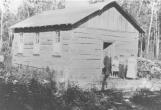 Credits:
Credits:Bob Duncan
Photographer - Julian Mills
Fort McMurray Historical Society
3
The 1920s1923
Mr. and Mrs. McTavish left McMurray in January 1923, and the schoolhouse burned down in May, not long after their departure. Mrs. Embree took over the teaching position when Cassia left. After the school burned down and only the shell and part of the cloakroom remained, lessons were held outside. Lessons were also held in the teacherage - her home - for the remainder of the school year. Classes for the following years were held in the First Presbyterian Church.
The school later became known as "McTavish University" after it burnt down and lessons were held outside.
1927-28
The new two-room schoolhouse was opened in order to replace the old schoolhouse that burnt down in 1923. This was located on Franklin Avenue, across from the location of the first school. It was originally known as the McMurray Public School, but eventually became part of the Peter Pond School. When the school opened, 40 students were enrolled ranging from grades 1 to 9. Grades 10 and up went to Edmonton for further education. The school was opened by the McMurray School District #2833 Chairman, Mr. Gerald Card.
4
P2011.92.3: Students taking lessons outside after the schoolhouse burnt down in 19231923
McMurray, Alberta, Canada
 Credits:
Credits:Mrs. Harry Halliday
Fort McMurray Historical Society
5
P993.34.84: Students gathered in front of the second McMurray Public School, circa 1927circa 1927
McMurray, Alberta, Canada
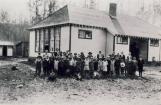 Credits:
Credits:Fort McMurray Historical Society
6
The 1930sSeptember 28, 1935
The Separate School Board, St. John's Roman Catholic School District #32, was formed in McMurray. The first school was built the following year.
1936
Bishop Breynat bought land for the first Catholic School in McMurray. St. John's opened with 45 students ranging from grades 1 to 10. Construction began in August. For the first few weeks of school, students were taught in the Catholic Church before they were able to move into the new school on September 26th.
Mary Redmond was one of the first two teachers at St. John's Roman Catholic School. She taught from September 1936 (when the school opened) until June 1940: grades 1-4; 30 students. Her students used kneelers for seating and a long bench as a desk.
Wilfred Loiselle, who was the first teacher for the senior students at St. John's, taught grades 5-9 with a few grade 10 students in the choir loft. He fell ill, however, and was replaced by Mr. Duchak in January 1937.
1938
St. John's was the first school in McMurray to offer education up to and including grade 12.
Waterways School District #4843 was formed.
1939
The next year, Waterways School District #4843 opened a school in the town of Waterways. 39 students were enrolled the first year, ranging from grades 1 to 7 with only 2 teachers. St. Aidan's Anglican Church opened at the same time and held classes for 22 students from 1939-1942, during the Second World War.
Abasand School District #4865 was in commission from December 19, 1939 to July 1, 1948, when it dissolved due to the dismantling and liquidation of the Abasand Oils Ltd. plant.
7
P2010.38.6: Grade 1 boys on the steps of St. John's School, 19361936
McMurray, Alberta, Canada
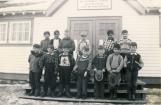 Credits:
Credits:O'Coffey Family Collection
Fort McMurray Historical Society
8
Map of McMurray with locations identified. Note: first Schoolhouse and Teacherage (centre, right)circa 1930
McMurray, Alberta, Canada
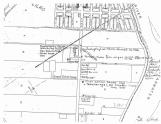 Credits:
Credits:Gerry Bussieres
Fort McMurray Historical Society
9
The 1940s1940
Teachers, Redmond and Duchak, left St. John's Roman Catholic School in 1940, and grades 10-12 were not offered during the war.
1942
Many more students attended the McMurray Public School in 1942 coinciding with the boom in McMurray during the Second World War because of the jobs available in the oil sands. McMurray Public School expanded to accommodate the new students.
May 30, 1947
McMurray became the Village of McMurray.
December 30, 1948
The Village became the Town of McMurray.
1949
St. Peter's Roman Catholic School District #38 was established.
10
P2008.207.7: St. John's School with children on the steps, circa 1936circa 1936
McMurray, Alberta, Canada
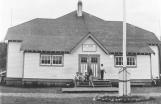 Credits:
Credits:Fort McMurray Historical Society
11
P2008.207.1: Father Lesage and the Bishop with five children, 19471947
McMurray, Alberta, Canada
 Credits:
Credits:Fort McMurray Historical Society
12
P2009.9.5: McMurray High School students, circa 1945circa 1945
McMurray, Alberta, Canada
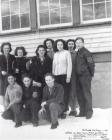 Credits:
Credits:Violet LeMay-Carmichael
Fort McMurray Historical Society
13
Mrs. Whitney, a favourite teacher, and her Grade 1 & 2 class, 1945-461945-46
McMurray, Alberta, Canada
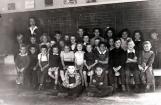 Credits:
Credits:Clausen Family Private Collection
Fort McMurray Historical Society
14
The 1950s1952-1954
Cassia Patton McTavish lived to be 91. She passed away in early November 1952, and Douglas Craig McTavish died in May 1954.
1955
Due to cutbacks, St. Peter's Roman Catholic School District #38 was dissolved.
The Waterways School District #4843 became part of the McMurray School District #2833.
1957
St. John's School built the first gymnasium in McMurray. Peter Pond School built a gym in 1961. Both schools expanded with more classrooms and offices, as well, in order to accommodate staff and students' needs.
1958
The McMurray School and the Waterways School had fallen into disrepair by 1958 and the town was going through an economic crisis. So many repairs and renovations were necessary that it was a more efficient use of funds to just build new schools as soon as it was financially possible.